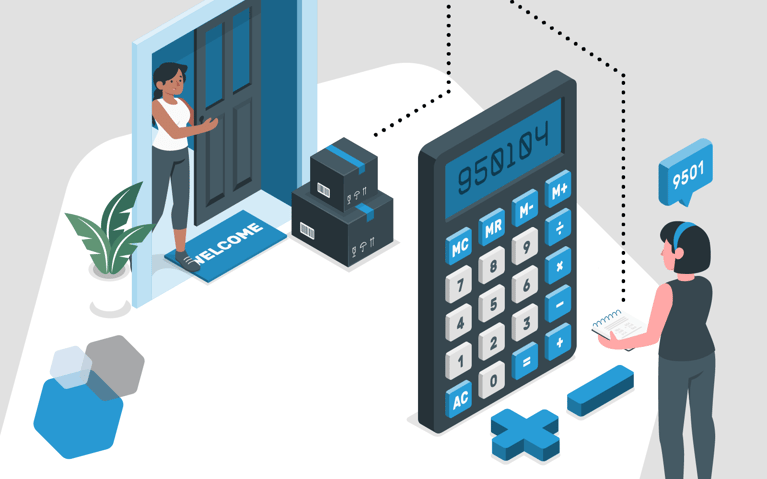A quick Google search about ecommerce shipping costs and you begin to realize how important it is. The cost of shipping has an enormous effect on both businesses and consumers. People commonly ask, “What’s a reasonable price for shipping” and “How do you determine shipping costs when selling online?” Ultimately, the actual cost – both what brands pay for shipping and what (if anything) consumers are charged – influences customer behavior and business success.The focus and expectations on shipping make a strong strategy critical to ecommerce success. Customers want fast and low-cost or free shipping, while retailers desire the most cost-effective option. The question becomes, how do you balance both needs? To keep costs low – and customers happy – brands must understand and optimize shipping. Otherwise, you run the risk of poor pricing strategies that drain resources that could instead go toward growth. A good place to start is with understanding and calculating dimensional (DIM) weight.
What is DIM weight?
In the past, commercial freight transporters (including postal carriers and couriers) calculated shipping costs based on the gross weight of packages in either kilograms or pounds. However, this method of charging by weight became unprofitable due to lightweight and low-density packages occupying a considerable amount of space in the truck, aircraft or ship in proportion to their actual weight.
The transportation industry adopted a pricing technique known as dimensional weight, also known as volumetric or cubed weight, to address the issue. DIM weight is calculated by multiplying a package's length, width and height (in inches or centimeters) and dividing by dimensional factor: In other words, calculating its physical space.
Shipping charges are based on whichever is greater, the dimensional weight or the actual weight of the package. This method has become universal for establishing a minimum charge for the cubic space a package occupies. UPS and FedEx both announced that starting in 2015, shipping charges on all shipments, whether by air or ground, would be determined by whichever was greater: the actual weight or the dimensional weight of the package. Prior to this announcement, dimensional weight charges only applied to packages within a specific size range.
Why DIM weight matters
With the explosion of ecommerce and the number of items shipped daily, DIM weight has the potential to reduce costs for brands that pack more efficiently. Additionally, reduced packaging helps lower fuel emissions, making it more environmentally friendly.
Think of DIM weight as a potential reward for retailers who eliminate excess packaging. By optimizing how they pack, shipment density increases, allowing carriers to fit more.
DIM weight vs actual weight
The actual weight (also called physical weight) of a package is the result of placing it on a scale. Actual weight is typically used when an item is heavy for its size. Actual weight is exactly what the product weighs, including its packaging. Carriers commonly use actual weight when items are shipped in carrier-supplied packaging.
DIM weight calculates the physical size and uses a freight carrier’s dimensional weight divisor. This divisor is a number set by carriers representing cubic inches per pound. For freight carriers like USPS, UPS or FedEx, the billable weight is whichever is higher between the actual versus DIM weight.
The DIM divisor
The dimensional divisor – or factor – is set by each carrier. This means it varies depending on which you use. For example, FedEx’s current DIM divisor is 139, while UPS’s is 166 for retail customers and 139 for daily rates.
Why how you pack is important
The global ecommerce industry is expected to grow steadily at a CAGR of 14.4%. A large part of the ecommerce industry involves shipping – and today’s consumer expects fast and low-cost or free shipping. The resulting increase in shipping activity requires brands and carriers to optimize shipments.
Consider a large, fragile item – like a mirror. It may not weigh much, but it’s easy to want to overpackage it to protect it from breaking en route. The problem becomes that the more packaging there is, the more room things take up, affecting how much a delivery truck can carry.
The purpose of DIM weight is to save retailers money and for carriers to be able to fit more. It works best when packing is done in a way that reduces “space.” It’s beneficial for both ecommerce merchants and freight shippers to optimize packing: Retailers spend less on shipping, and carriers get more items into each shipment. In the era of fast shipping – this is critical.
Putting small items in a large box or using excess packing materials isn’t cost-effective. Instead:
- Choose materials that match both the fragility and size.
- Explore your packaging options – there are a large variety of choices.
How to calculate dimensional weight
Dimensional weight is calculated by: (L x W x H)/the dimensional divisor. The steps you’ll take are:
Step 1: Multiply the length, width and height to determine its cubic size. The measurement of each size should be rounded up to the nearest whole number. Make sure to factor any misshapen areas or bulges that could result in extra handling fees.
Your calculation should look like this: 18 in. x 15 in. x 12 in. = 3240 cubic inches
Step 2: To calculate the DIM weight, divide L x W x H (3240 cubic inches) by the dimensional divisor. In this example, FedEx’s 139.
Your calculation should look like this: 3240/139 = 23.31 lbs.
Step 3: Round the DIM weight up to the nearest whole number.
DIM weight = 24 lbs.
Let’s say the package had an actual weight of 11 lbs. In this scenario, the billed weight would be the DIM weight, at 24 lbs.
How using a 3PL helps you manage DIM weight
While calculating DIM weight isn’t difficult, it can get harder when creating a shipping strategy and determining costs for multiple products, bundles or combined orders. A 3PL works with its customers to optimize shipping: Both packaging and the cost of shipping. They also help by:
- Keeping dimensional weight down: 3PL teams are packing and shipping experts. They see every type of packaging and can work with you to keep both actual and DIM weight down. 3PL providers can also streamline packaging processes and work with you on a fulfillment strategy that ensures you pay the best rates for shipping your product.
- Staying current on industry changes: Things change – often frequently – and it can feel challenging to keep up with every notification or announcement. A 3PL service stays current on carrier changes, pricing changes and more, to make sure their clients can adapt and maintain optimal costs and avoid any additional fees.
- Negotiating prices with carriers: Carriers don’t have uniform pricing. And you aren’t always able to see the hidden deals. A 3PL solution is often aware of nuances between services and knows who to talk to and how to negotiate better rates.
Subscribe to our emails for the latest industry insights!
By entering your email, you agree to receive marketing emails from Cart.com






